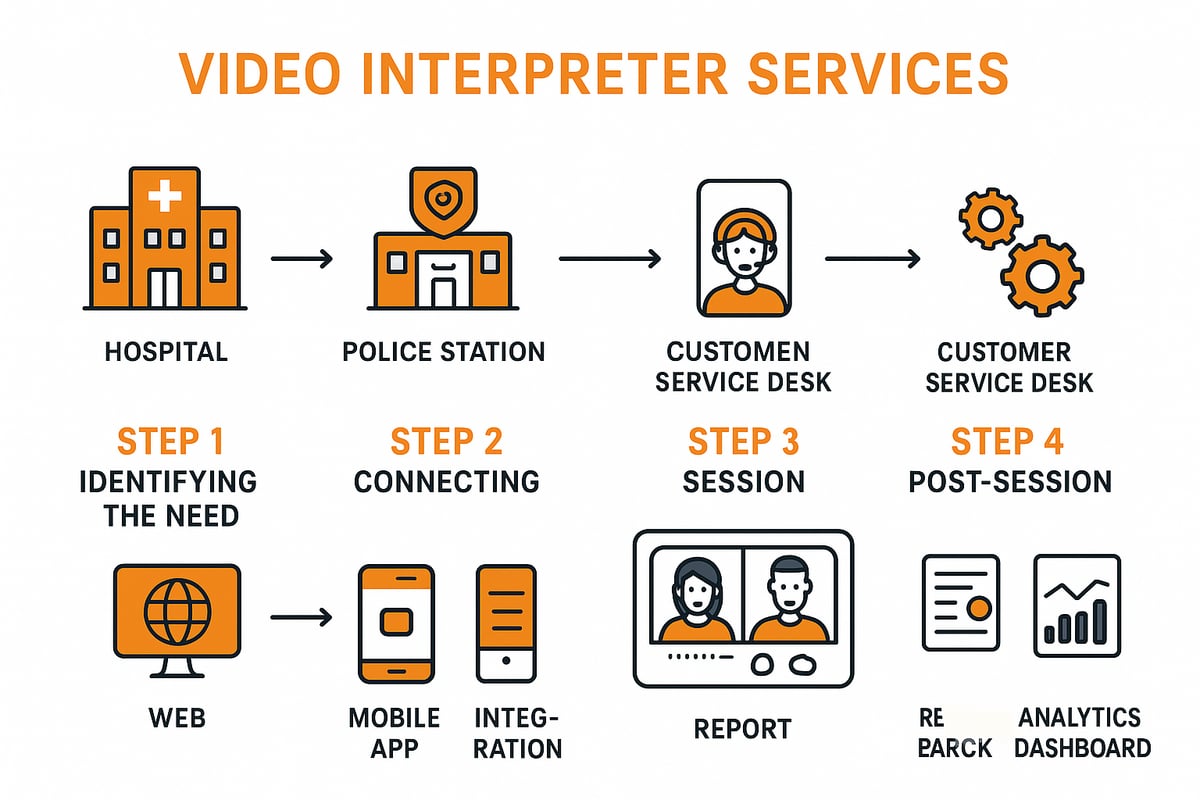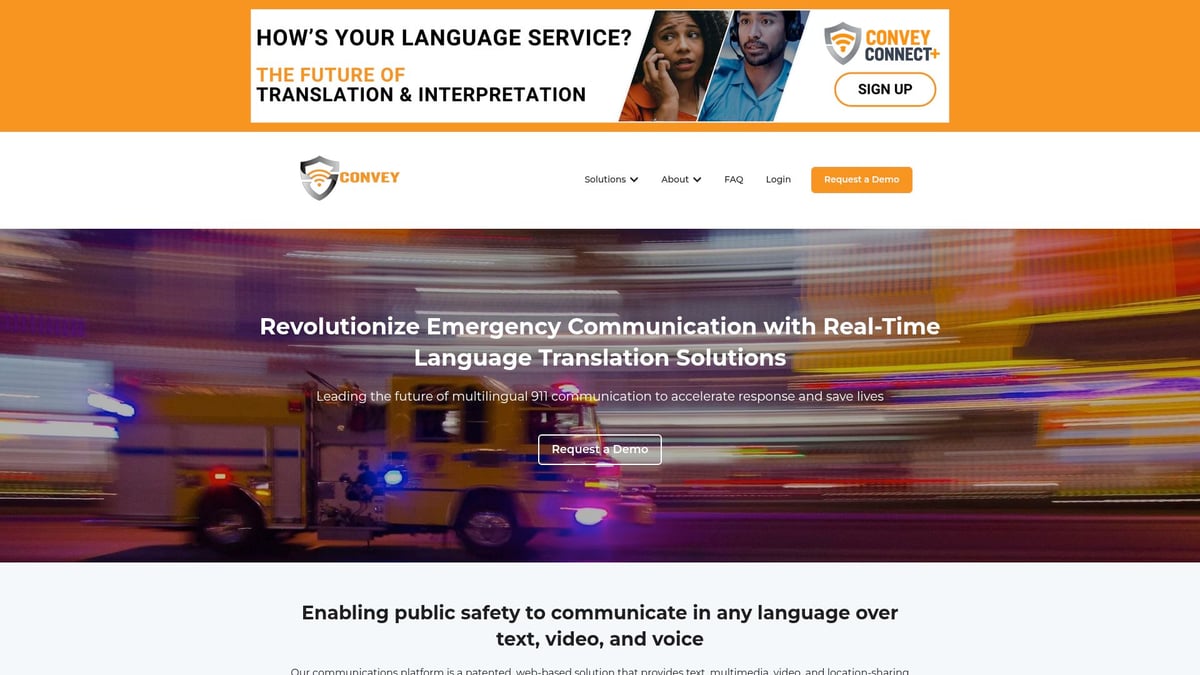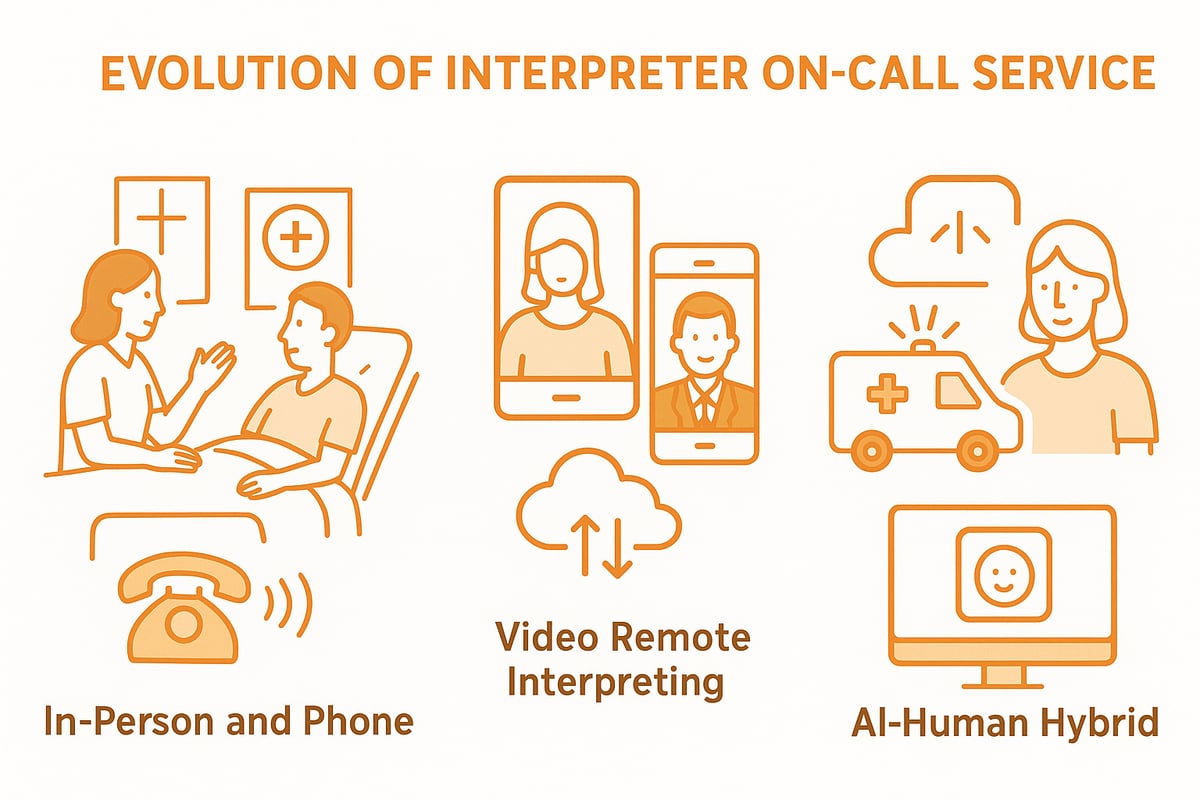In a world where communication can be the difference between confusion and clarity, having access...
The Essential Guide to Video Interpreter Services (2025)
Imagine facing a critical situation where every second counts, but language differences stand in the way of clear communication. In 2025, video interpreter services are essential for overcoming these barriers, ensuring that conversations remain effective and inclusive. This guide reveals how video interpreter services bridge communication gaps, enhance accessibility, and elevate customer experiences across industries. Discover what these services are, their core benefits, how they operate, the latest technology trends, top real-world use cases, and how to choose the right provider. Let us help you make informed decisions that drive progress and inclusion.
Understanding Video Interpreter Services: Definition, Types, and Evolution
In a world where communication is instant and global, video interpreter services have become essential for bridging language gaps. These solutions provide real-time interpretation using video, supporting clear and accurate conversations across borders, industries, and communities.

What Are Video Interpreter Services?
Video interpreter services deliver live language interpretation via secure video connections, enabling participants to communicate effectively regardless of language barriers. Unlike in-person or audio-only interpretation, these services allow interpreters to see facial expressions and gestures, which adds clarity and reduces misunderstandings.
Common platforms include video conferencing tools like Zoom, as well as specialized solutions designed for medical, legal, and customer service environments. Certified interpreters play a pivotal role in ensuring accuracy and confidentiality, especially in sensitive settings. Typical use cases for video interpreter services include healthcare consultations, courtroom proceedings, educational meetings, and customer support interactions.
Evolution of Video Interpretation: Past to Present
The journey of video interpreter services began with early video relay systems for the Deaf and Hard of Hearing, progressing to today's cloud-based, on-demand platforms. The COVID-19 pandemic accelerated adoption, making remote language access a necessity for organizations worldwide.
Technological advancements in video streaming, artificial intelligence, and security have transformed the industry. According to Global interpretation services market growth projections, the global VRI market is expected to reach $2.5 billion by 2025, highlighting rapid expansion. Increasing regulation now requires many sectors to provide accessible communication, further driving the growth of video interpreter services.
Types of Video Interpreter Services (On-Demand, Scheduled, Hybrid)
Video interpreter services are offered in several formats to suit different needs. On-demand services connect users with interpreters in under a minute, ideal for emergencies or unpredictable scenarios. Scheduled services are arranged in advance for planned meetings, ensuring the right language expertise is available.
Hybrid models blend AI-powered automation with human interpreters for greater efficiency. Industry-specific options exist, such as medical VRI, legal VRI, and business-focused platforms. Many providers support over 100 languages and offer video relay services for the Deaf and Hard of Hearing, making video interpreter services accessible to diverse populations.
| Type | Response Time | Use Cases | Accessibility |
|---|---|---|---|
| On-Demand | <60 seconds | Emergencies, ER | VRS, Multilingual |
| Scheduled | Pre-booked | Legal, Education | Certified Experts |
| Hybrid | Instant/Planned | Customer Service | AI + Human Support |
Benefits of Video Interpreter Services
Organizations benefit from immediate access to qualified interpreters through video interpreter services, which support visual cues and nonverbal communication for greater accuracy. These solutions typically reduce costs compared to in-person interpretation and help organizations comply with accessibility laws such as ADA and Title VI.
For example, a hospital using video interpreter services reported reduced emergency room wait times, as patients received language support faster. This leads to improved outcomes and higher satisfaction for both clients and staff. The ability to document sessions and monitor quality further enhances the value of video interpreter services.
How Video Interpreter Services Work: Step-by-Step Process
Clear communication is vital when every second counts. Video interpreter services streamline multilingual conversations with a structured, reliable process. Let us walk through each step to see how these services deliver rapid, accurate support across critical scenarios.

Step 1: Identifying the Need for Interpretation
The first step in leveraging video interpreter services is recognizing when language support is essential. Common situations include medical emergencies, legal proceedings, customer service interactions, and public safety events.
Frontline staff or automated tools may use language identification cards, digital prompts, or multilingual greetings to quickly determine the needed language. Having clear protocols in place ensures no time is lost during urgent moments.
Rapid identification is crucial, as delays can impact outcomes in healthcare, courtrooms, or crisis response. By embedding video interpreter services into workflows, organizations ensure every individual receives timely, understandable communication.
Step 2: Connecting to a Video Interpreter
Once the need is established, connecting to a video interpreter is seamless. Users may access services through web portals, mobile applications, or integrated platforms within telehealth or emergency dispatch systems.
Most video interpreter services connect users with a qualified interpreter in under 60 seconds. Security is paramount, with leading providers ensuring HIPAA and GDPR compliance to protect sensitive information. In critical environments like 911 centers, integrating both AI and human interpreters can further accelerate connections and accuracy, as detailed in AI and Human Interpreters in 911.
A secure and user-friendly connection process helps organizations maintain trust while delivering rapid support.
Step 3: Conducting the Interpreted Session
During the interpreted session, the video interpreter services platform facilitates clear, confidential communication. The interpreter maintains strict neutrality and ensures every message is accurately conveyed between all parties.
Sessions may involve multiple participants, such as doctors, patients, and family members, or attorneys and clients. Video interpreter services often support visual aids, screen sharing, and document uploads to enhance understanding and reduce miscommunication.
Best practices include speaking clearly, allowing the interpreter time to relay information, and using visual cues when possible. These steps help ensure every participant feels heard and understood.
Step 4: Post-Session Procedures and Reporting
After the session ends, video interpreter services provide robust post-session support. This includes documenting session details for compliance, such as time, language, and interpreter credentials.
Organizations benefit from integrated quality assurance tools and feedback surveys, enabling continuous improvement. Billing is automated and transparent, while analytics dashboards offer insights into usage patterns and performance.
By streamlining reporting and follow-up, video interpreter services help organizations meet regulatory requirements and optimize language access programs for future needs.
Key Technologies Powering Video Interpreter Services in 2025
Rapid advances in technology are redefining what video interpreter services can achieve in 2025. These innovations make language access faster, more secure, and more inclusive for organizations and individuals worldwide.

AI and Machine Learning Enhancements
AI and machine learning are at the heart of modern video interpreter services. Real-time language detection enables instant routing to the right interpreter, while AI-driven speech recognition and translation boost both speed and accuracy.
Many providers now use a human-in-the-loop system, where AI handles routine tasks, but certified interpreters step in for complex conversations. Industry data shows that AI can reduce connection times by up to 40 percent, making urgent communication more efficient.
For a deeper look at industry trends and the impact of AI on language access, see Language services industry trends and statistics.
These advancements ensure video interpreter services remain responsive as demand grows across sectors.
Secure Cloud Infrastructure and Data Privacy
Security is a non-negotiable aspect of video interpreter services. Providers rely on end-to-end encryption and secure cloud storage to safeguard sensitive information.
Platforms follow strict regulations such as HIPAA and GDPR, and often use specialized environments like AWS GovCloud for enhanced compliance. Organizations benefit from audit trails and detailed access controls, which are critical for accountability.
With robust cloud infrastructure, video interpreter services can scale globally while maintaining the privacy and integrity of every session.
Multi-Platform and Device Integration
Flexibility is essential for video interpreter services to meet diverse user needs. Leading solutions work seamlessly across desktops, tablets, and smartphones, ensuring accessibility in any environment.
Integration with telehealth systems, CRM platforms, and emergency dispatch centers is now standard. Intuitive interfaces and built-in accessibility features make it easy for all users to connect and communicate.
This multi-platform approach ensures video interpreter services fit smoothly into existing workflows and adapt to changing demands.
Accessibility and Inclusion Technologies
Accessibility is a core value driving innovation in video interpreter services. Video relay services support the Deaf and Hard of Hearing, while real-time captioning and visual aids enhance comprehension for all participants.
Many platforms now offer support for over 100 languages, ensuring that language is never a barrier to critical services. For example, school districts use these tools to improve communication between parents and teachers from diverse backgrounds.
By prioritizing inclusion, video interpreter services empower organizations to serve every community effectively.
Top Use Cases and Industries for Video Interpreter Services
Clear communication is essential in nearly every sector, especially when language barriers stand in the way. Video interpreter services have become a crucial bridge, supporting diverse industries and ensuring no one is left behind during critical interactions.
Healthcare: Telemedicine, Hospitals, and Clinics
In healthcare, video interpreter services are transforming patient interactions. Hospitals, clinics, and telemedicine providers rely on these solutions for ER visits, patient intake, mental health consultations, and routine care. The demand is driven by strict federal language access laws and the need for precise, culturally competent care.
According to Modern Healthcare, 25% of US hospitals now use video interpreter services to reduce medical errors and improve outcomes. Real-time access to certified interpreters leads to faster, safer care and improved patient satisfaction. For further insights, see Enhancing Healthcare Communication.
Legal and Judicial Systems
Legal proceedings require accurate communication to uphold due process. Video interpreter services enable courts to provide interpretation for hearings, depositions, and attorney-client meetings, even when participants are remote. Regulatory mandates now require language access in many courtrooms, making these solutions indispensable.
State court systems have integrated video interpreter services for remote arraignments and other proceedings. This ensures equal access to justice and compliance with evolving legal standards. The presence of certified interpreters maintains confidentiality and neutrality throughout each step.
Business and Customer Service
Global business operations depend on clear, multilingual communication. Video interpreter services empower customer support teams and business process outsourcing centers to connect with clients in their preferred language. This not only enhances the customer experience but also boosts satisfaction and retention rates.
Companies using video interpreter services report up to 30% higher satisfaction scores among non-English-speaking clients. These tools offer on-demand access, scalability, and cost savings compared to hiring in-person interpreters or relying on bilingual staff alone.
Education and Social Services
Educational institutions and social service agencies use video interpreter services to promote equity and inclusion. Schools deploy these solutions during parent-teacher conferences, IEP meetings, and counseling sessions, supporting students and families from diverse backgrounds.
School districts offering video interpreter services in 25 or more languages see improved engagement with immigrant and refugee families. Social workers and counselors can provide timely support, ensuring all voices are heard and understood in critical conversations.
Emergency Services and Public Safety
In emergencies, every second counts. 911 call centers, police, fire, and EMS teams use video interpreter services to communicate with limited English proficient individuals during crises. This technology speeds up dispatch, clarifies vital details, and can ultimately save lives.
Cities using video interpreter services have reported reduced emergency response times and better outcomes for all community members. Language support is available for hundreds of languages, making public safety accessible to everyone, regardless of background.
Convey911: Bridging Language Gaps in Emergency Situations
Convey911 stands out for delivering real-time video interpreter services to 911 centers, PSAPs, and first responders. Supporting over 185 languages, it combines AI and certified human interpreters for unmatched speed and accuracy.

With more than 50,000 minutes of live interpretation handled monthly in North America, Convey911’s proprietary technology identifies languages in under 2 seconds. This ensures compliance with accessibility laws and strict government security standards. Agencies using Convey911 provide faster, more accurate emergency assistance, empowering safer, more inclusive communities.
How to Choose the Right Video Interpreter Service Provider
Selecting the right video interpreter services provider is a critical decision for any organization aiming for clear, compliant, and effective multilingual communication. With so many options available, understanding what to look for can help you avoid costly missteps and ensure reliable support for your team and clients.
Assessing Language Coverage and Industry Expertise
Start by evaluating the language coverage offered by video interpreter services. Leading providers should support a wide range of languages and dialects, including those most relevant to your client base.
Industry expertise is equally important. For example, if your organization operates in the legal sector, you need interpreters trained in legal terminology and protocols. Providers with experience in your specific field will ensure accuracy and professionalism. To see how specialized solutions can benefit law firms, review Multilingual Communication for Law Firms.
Look for:
- Comprehensive language lists
- Certified interpreters in specialized fields
- Case studies or testimonials in your industry
Evaluating Technology, Security, and Compliance
Modern video interpreter services must offer robust technology and stringent security features. Assess the platform for end-to-end encryption, data protection, and compliance with regulations such as HIPAA or GDPR.
Integration with your existing systems, such as telehealth or case management platforms, is a key factor. Reliable providers also maintain transparent audit trails and access controls for sensitive information. For insights into technology and compliance trends in healthcare, consider the Virtual interpreter services in healthcare market analysis.
Checklist:
- Encryption and secure data storage
- Regulatory compliance certifications
- Easy integration with current workflows
Service Quality, Availability, and Support
Quality of service sets top video interpreter services apart. Confirm the availability of 24/7 on-demand access, as urgent situations can arise at any time. Average connection times should be under a minute to prevent service delays.
Interpreter qualifications are essential. Ask about ongoing training, quality assurance processes, and feedback mechanisms. Responsive customer support and clear service-level agreements (SLAs) provide peace of mind when issues occur.
Service quality indicators:
- 24/7 interpreter availability
- Average connection times
- Ongoing interpreter training
- SLA and support responsiveness
Cost, Scalability, and Contract Flexibility
Finally, compare pricing models for video interpreter services. Transparent rates, whether per-minute, subscription, or enterprise, make budgeting easier. Check for hidden fees and ensure the provider can scale as your organization grows.
Contract terms should offer flexibility, including trial periods or easy cancellation policies. This allows you to test the service and adjust as your needs evolve. Consider using a table to compare key contract features from several providers.
| Feature | Provider A | Provider B | Provider C |
|---|---|---|---|
| Pricing Model | Per-minute | Subscription | Hybrid |
| Scalability | Yes | Yes | Limited |
| Contract Flexibility | High | Medium | High |
Choosing a provider with transparent pricing and scalable solutions will help your organization maximize the value of video interpreter services.
Future Trends and Innovations in Video Interpreter Services
As we look ahead, video interpreter services are evolving at a rapid pace. New technologies and regulatory shifts are reshaping how organizations bridge language gaps, making communication more seamless and inclusive than ever before.
AI-Driven Automation and Real-Time Translation
Artificial intelligence is transforming video interpreter services with smarter automation and real-time translation. Advanced AI models now rapidly detect languages and route calls to the right interpreters. Predictive analytics forecast interpreter demand, ensuring resources are ready during peak times. These innovations minimize wait times and drive down operational costs. Human-in-the-loop systems remain crucial, as they combine AI speed with certified interpreter accuracy. As automation matures, organizations benefit from faster connections and improved service quality. The future of video interpreter services is defined by a balance of efficiency, reliability, and human expertise.
Expanding Accessibility: New Languages and Modalities
Accessibility is at the heart of video interpreter services innovation. Providers are expanding support for indigenous and low-resource languages, reaching communities previously left out of digital conversations. Emerging modalities like wearable devices and AR/VR interfaces are making real-time language support available in more situations, from remote fieldwork to immersive classrooms. Enhanced features cater to neurodiverse users, promoting true inclusivity. With multilingual support for over 100 languages, video interpreter services are breaking barriers and empowering organizations to communicate effectively with every audience, regardless of linguistic or physical challenges.
Regulatory and Policy Developments
The regulatory environment for video interpreter services is rapidly evolving. Anticipated changes to language access laws will set higher standards for both public sector and private organizations. Global guidelines are emerging for interpreter certification and secure technology use, ensuring consistent quality worldwide. Compliance with HIPAA, GDPR, and accessibility mandates is now non-negotiable, driving providers to adopt rigorous security and documentation protocols. For emergency response, new regulations highlight the critical role of language access. As described in Bridging the Language Gap in 911, these developments ensure equitable communication and public safety for all.
The Role of Video Interpretation in a Connected World
Video interpreter services are becoming a foundational pillar in our increasingly interconnected society. Migration, globalization, and the rise of remote work have created unprecedented demand for seamless language access. Cultural competence and sensitivity are now integral to interpreter training, ensuring more effective communication across borders. Video interpreter services promote digital inclusion, enabling equal participation in healthcare, justice, education, and emergency services. As organizations prioritize accessibility and customer experience, these services will continue to empower communities and support meaningful global connections.
As we’ve explored, bridging language barriers in critical moments can make all the difference—especially in high-stakes environments like emergency response, healthcare, or customer service. If you’re ready to see how leading-edge video interpreter services can transform your communication capabilities and ensure everyone gets timely, accurate support, why not experience it firsthand? You can connect with Convey911’s innovative platform, discover intuitive tools, and ask specific questions tailored to your organization’s needs. Let’s take the next step together—Book a Demo to see how seamless, real-time language access can empower your team and strengthen your community.



